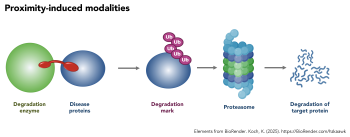21 Aug 2025 - European alliance to advance proximity-induced drug modalities
In a now published Perspective in Molecular Cell, scientists from six leading European research institutions, Goethe University Frankfurt, IRB Barcelona, AITHYRA in Vienna, the University of Dundee, and EPFL Lausanne, propose the creation of a European Alliance to accelerate the development of proximity-induced drug modalities. These therapeutic approaches aim to harness the concept of bringing molecules into close proximity to target disease-relevant proteins, many of which are currently considered undruggable.
Proximity-inducing drug modalities, such as proteolysis-targeting chimeras (PROTACs) and molecular glue degraders, function by reprograming the cellular machinery to modify or eliminate disease-causing proteins. Originating from the concept of harnessing the cell’s own waste-disposal system to direct specific proteins toward degradation, these approaches have transformed the way scientists approach targeting disease mechanisms. Unlike traditional inhibitors, proximity-inducing drugs can remove entire proteins, and the concept has meanwhile expanded beyond degradation to the broader rewiring of cellular pathways.
In Germany, the PROXIDRUGS Cluster4Future, led by Goethe University Frankfurt, drives the development of this revolutionary class of drugs. Since October 2021, PROXIDRUGS has secured annual funding of €5 million from the German Federal Ministry of Research, Technology and Space (BMFTR). It has built a broad national network of academic and industrial partners, which now aims to expand to the international level. At the heart of the PROXIDRUGS cluster, Goethe University contributes decade-long expertise in researching cellular waste disposal pathways, especially the ubiquitin-proteasome and autophagy systems. It also houses the newly founded Frankfurt Center for Emerging Therapeutics (FCET), an innovation hub for cutting‑edge interdisciplinary research, offering key platforms and enabling rapid technology transfer.
„Proximity-inducing strategies could prove to be game-changers for drug development,” says Ivan Đikić, IBC2 Director, and one of the authors of the perspective. “Integrating our national efforts with other internationally leading institutions will accelerate the pace of innovation. Our vision goes beyond building academic networks in fostering broad industry collaboration”
The now published Perspective outlines recent scientific breakthroughs, including the evolution of PROTACs from concept to clinic, rational design of molecular glues, and novel strategies to redirect cellular degradation machinery. It also discusses how AI and machine learning have the potential to transform and accelerate discoveries in this field. Proximity-induced drugs can address biological targets that are inaccessible to conventional inhibitors and hold promise for the treatment of a range of “undruggable” diseases.
The authors of this article emphasize the foundational role of academia in advancing this field and call for tighter academic-industry collaboration to unlock its full therapeutic potential. Their research centres in Vienna, Dundee, Barcelona, Frankfurt, and Lausanne have built complementary expertise in medicinal chemistry, structural biology, biophysics, cell biology and computational methods. Although collaborations already exist, they are often limited in scope and duration.
The proposed European Alliance aims to pool expertise, infrastructure, and digital platforms across Europe. It would facilitate access to and coordinate the benchmarking of technologies, improve the integration of laboratory-driven and computational discovery approaches, and develop in vivo models to address delivery and safety challenges. The authors propose to seek both public and private funding to connect existing European hubs with international partners, including pharmaceutical companies, biotechnology firms, and technology developers.
“The pre-competitive space is where academic freedom, methodological innovation, and industrial experience can reinforce one another“, says Đikić. „This is where an alliance can deliver the greatest impact, motivate other partners to join and increase the likelihood of novel concepts progressing efficiently from lab to life.“
